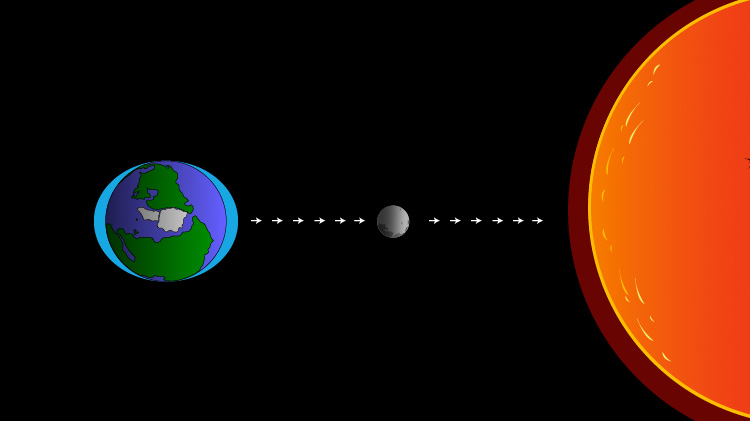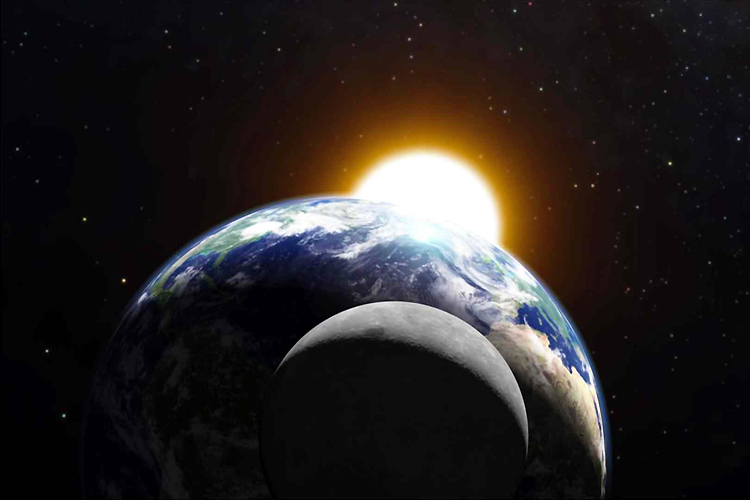Tides are the sum of effects caused by the gravitational attraction of the Moon and the Sun.
However, it's the Moon that matters because it is closer to the Earth.
There is a much larger difference in the Moon's gravitational field between the Earth's near-surface, the Earth's center, and the Earth's far surface than for the Sun.
This means that the Moon's contribution to the Earth's tides is roughly double that of the Sun.
The reason the Moon has a greater effect on the Earth's tides is not the magnitude of its gravitational force over the Earth but because it's closer to us than the Sun.
And because it is much closer, the Moon is constantly attracting the waters of the Earth.
The gravitational attraction between the Earth and the Sun is more than 177 times that between the Earth and the Moon, but because the Sun is 390 times further from the Earth than the Moon, the Moon rules the tidal movement.
There's a major difference - 6 percent - in its gravitational pull on the water on the near side vs. the far side, while for the Sun, the difference is much less (even though the Sun's gravitational force is greater).
It's the difference from the near to the far side that's important in creating tides, not the absolute strength of the gravitational pull.
The Sun's impact on the tides is 44 percent that of the Moon, i.e., slightly less than half.
When the Moon is in line with one side of the Earth, it pulls on the water, causing a high tide.
Because the Earth rotates on its axis, the Moon completes one orbit in our sky every 24 hours and 50 minutes.
Thus, we observe two tidal peaks - as well as two tidal troughs - roughly every 12 hours.

Since the Moon moves around the Earth, it is not always in the same place at the same time each day.
So, each day, the times for high and low tides change by 50 minutes.
When the Moon, Earth, and Sun are perfectly aligned, the sum of the gravitational pull of the Sun and Moon causes maximum tides or extreme tides.
When the Moon lies between the Earth and the Sun, we observe a New Moon.
When the Moon is on the opposite side of the Earth from the Sun, a Full Moon is visible.
In both cases, tides are 20 percent lower and higher, respectively, than the normal tides.
Tides and Surfing: A Random Equation
The Guinness Book of World Records declared that Bay of Fundy's Burntcoat Head, in Canada, has the greatest mean spring range with 47.5 feet (14.5 meters) and an extreme range of 53.5 feet (16.3 meters).
Tides change our favorite waves and spots, but they also alter the way we surf them.
With time, experience, and observation, you'll notice that tides can be more important than the classic swell variables of height and period.
Many times - if not always - the ideal conditions of a surf break are a sensitive combination of tides, swell, and wind.
That is why planning your surf session around the tides is, quite often, highly stressful.
In many breaks, and with the right combination of swell and wind, surfing is only possible on low and high tides.
In other wave peaks, mid-tide conditions will guarantee the best surf.
These variables can be considered, along with the ocean floor and shore geography, to establish standard patterns for above-average surfing days.
But the bottom line is that surfers must adapt to tide times to score the best waves in a relatively short time window.
Discover the tidal "Rule of Twelfths" in surfing. For more information, consult your region's tide times, charts, and tables.
